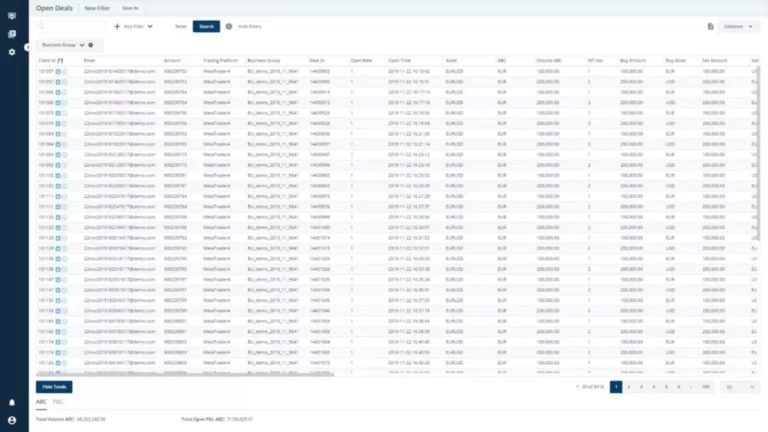Centralized Exchange CEX Vs Decentralized Exchange DEX
Xem nhanh
Content
Although DEXs are growing in popularity, one can’t deny that CEXs still dominate them in terms of the trading volume. That means the overall risk in the event of a hack is lower when using a DEX. CEXs act as on-ramps and off-ramps, Mining pool meaning users can easily convert fiat into crypto and vice versa. In this article, we review the major differences between CEXs and DEXs so you can make an informed decision about where to make your next crypto trade. Overall, the chances of making an irreversible mistake like losing access to your funds or transferring it to the wrong address are much lower with a CEX.
- On the other hand, a “DEX,” which stands for decentralized exchange, is a fully automated exchange that operates without holding the private keys of its users.
- For instance, the Bank Secrecy Act (BSA) governs cryptocurrency trading platforms in the USA.
- Decentralized exchanges (DEX) operate without the need for a third party.
- The exchange will also take custody of the assets you want to trade on the CEX after you’ve deposited them into your CEX account.
- If you want to use a decentralized exchange, you need to already have a cryptocurrency wallet, as well as some funds within it.
HOW TO CHOOSE A CRYPTOCURRENCY EXCHANGE
When using a DEX, there’s no need to supply personal, identifying https://www.xcritical.com/ information and trust it to be stored securely. This means your personal data is safe from bad actors who want to steal your identity. Note that when using an exchange, you are still bound by local regulations and laws.
What is a Decentralized Exchange (DEX)?
For example, back in 2021, CEXs saw over $14 trillion in trading volume while DEXs only topped $84.98 billion in the same period. In the absence of an order book to assess supply and demand to dex vs cex update assets’ prices, AMMs use a mathematical formula. Initially, DEXs used on-chain order books, but this required every node of a blockchain to record a trade order before the order could get completed.
XRP Wallets: How to create and set up an XRP wallet
Despite CEXs launching new tokens frequently, DEXs still dominate most new token sales and liquidity. Indeed, if we were to look at our earlier example with the drive-on-demand services and traditional taxis, the differences between the two are, admittedly, pretty negligible. Eventually, you would still end up driving to your friend’s house – so, the end goal is the same. That’s fine for a lot of people – at the same time, though, there are others who are less keen on handing over their names and payment details to a huge company.

Instead of relying on a central company to operate, decentralized exchanges use self-executing, autonomous smart contracts to process token swap requests. Centralized and decentralized exchanges are platforms for trading cryptocurrencies. They offer users a secure environment for trading digital assets since it removes your dependency on a centralized entity. Users typically interact with decentralized exchanges through websites that provide a user-friendly visual interface. For example, if you want to swap tokens on Uniswap, you would typically go to the app.uniswap.org interface. However, there can be many different interfaces that connect to the same underlying decentralized exchange.
Newcomers to crypto have access to simple conversion tools like Binance Convert, while experienced traders can use the Spot Exchange’s TradingView tools. A CEX will also likely have detailed guides as part of its services (Binance Academy is one example). CEXs, due to their centralized nature, could be more vulnerable to hacking. On the contrary, DEXs leverage blockchain technology, making them theoretically more secure.
The first time many people interact with crypto is through a cryptocurrency exchange. The only difference is that crypto exchanges deal in cryptocurrencies like Bitcoin (BTC) and Ethereum (ETH). The exchange controls the private keys, meaning they have custody of your assets. While this makes it easier to manage and trade your crypto, it also opens you up to the risks of a third party controlling your coins. CEX wallets are built into the exchange; any coins held there are in a CEX wallet by default.
A DEX also has several benefits but these are typically more attractive to experienced crypto users who value decentralization over ease of use. The fundamental distinction between a CEX and a DEX lies in their operational structure. A CEX is managed by a central authority that oversees all transactions, similar to a traditional bank. On the other hand, a DEX operates on blockchain technology and allows peer-to-peer trades without any central authority. The question of which between the CEX and DEX is more secure is a tough one. On the one hand, centralized exchanges are often deemed more reliable due to their sophisticated, centralized trading platforms.
These platforms are popular due to their ease of use, extensive asset offerings, and beginner-friendly features. A decentralized exchange is a peer-to-peer marketplace where you may trade cryptocurrencies directly with other users, bypassing the middlemen. Instead of matching buyers and sellers, the trades on AMM DEXs use liquidity pools managed by the DEX’s own smart contract. The pool’s liquidity comes from users who provide their coins or tokens in exchange for passive income.
For more information on the topic, refer to our What Is a Decentralized Exchange (DEX)? If you’re happy with the services offered by the CEX you’re using, there’s no need to switch. For many, a CEX offers the right balance of ease of use and available support. What are the regulatory implications for CEXs and DEXs, and how does this impact their operation and user base? DEXs, by being decentralized, escape most of these regulations, which can lead to a different user base and operational methods. Once validated, the exchange equips users with their login details to access their accounts, familiarize themselves with the rules and regulations, and commence trading.
This is as simple as a long list of buy and sell orders, where the highest and lowest buy and sell orders are executed first. In the jargon-filled world of crypto, CEX and DEX are two of the terms you’ll see cropping up the most. They are both types of exchange, but with some fundamental differences.
At the heart of the operation are the order book and exchange entity, making the model centralized. To use a CEX like Binance, you must create an account and verify your identity according to local regulations. The exchange will also take custody of the assets you want to trade on the CEX after you’ve deposited them into your CEX account. You don’t need to register for a DEX, meaning they’re open to anyone with a wallet and some crypto. DEXs are the gateway to the decentralized finance (DeFi) world and provide users with a lot of freedom. However, they lack the support a CEX can give, and it can be easy to make irreversible mistakes when using them.
In contrast, CEX usually has better security measures and compensation mechanisms. Furthermore, the graphical user interface is sometimes too complex for beginners. Moreover, many traders do not have access to limit orders, margin transactions, or stop losses. However, most decentralized exchanges are focused on implementing the CEX-like functionality. Both centralized and decentralized exchanges offer unique advantages and drawbacks that cater to different needs and preferences within the cryptocurrency community. As a beginner, it’s crucial to consider your priorities when choosing between these two options.

Almost every — if not every — service you use on a CEX will incur a transaction fee. Due to their higher operating costs, CEXs may struggle to compete with the low transaction fees offered by DEXs. However, a CEX’s additional transaction fees must be weighed against the gas fees of using a DEX, which can be considerable on some networks. As large centralized entities, CEXs are frequently the targets of attacks, which means any user funds stored on a CEX are susceptible to theft. While CEXs prioritize security, they cannot eliminate the risk of hacks and theft. Over the years, several high-profile hacks have occurred, such as the Mt. Gox hack.
The process of registering with a CEX is similar to opening a bank account. Many of us are already familiar with this system, and technical knowledge is not a must-have. Most CEXs offer payment with credit or debit cards, making your first crypto investment as simple as possible. It’s noteworthy to mention that while DeFi offers a spectrum of financial services, each requires a distinct protocol. In contrast, CEXes offer a more integrated platform, consolidating various services under one umbrella. If you’d like to figure out what is a DAO in a thorough way, there’s a dedicated section for that in our Crypto 101 Handbook – check it out!
